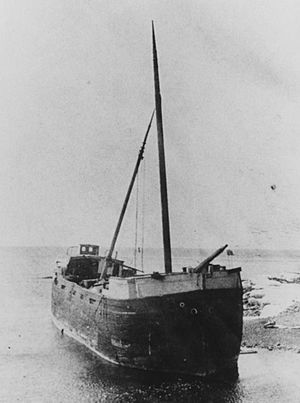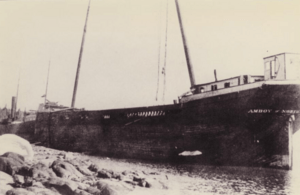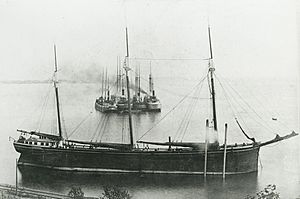Amboy (ship) facts for kids
 
The Amboy aground after the Mataafa Storm
|
|
Quick facts for kids History |
|
|---|---|
| Name | Amboy |
| Operator | Tonawanda Iron & Steel Company |
| Port of registry | |
| Builder | Quayle & Murphy |
| Completed | 1874 |
| Out of service | November 28, 1905 |
| Identification | U.S. Registry #95276 |
| Fate | Ran aground on Lake Superior in the Mataafa Storm of 1905 |
| General characteristics | |
| Tonnage |
|
| Length | 209.3 feet (63.8 m) |
| Beam | 34.2 feet (10.4 m) |
| Height | 14.4 feet (4.4 m) |
|
Amboy Shipwreck Site
|
|
| Location | Lake Superior, about a mile southwest of Sugar Loaf Cove |
| Built | 1874 |
| Architect | Quayle & Murphy |
| NRHP reference No. | 94000341 |
| Added to NRHP | April 14, 1994 |
The Amboy was a wooden schooner barge, a type of ship designed to carry cargo. She was often pulled by another boat. Built in 1874, the Amboy sailed on the Great Lakes, mainly carrying iron ore. Sadly, she sank during a huge storm called the Mataafa Storm in 1905 on Lake Superior. This happened near Schroeder, Minnesota. Today, her remains are an important historical site. They were added to the National Register of Historic Places in 1994.
Contents
The Amboy's Story
The Amboy (Official number 95276) was a wooden schooner barge. She was built in 1874 by Quayle & Murphy in Cleveland, Ohio. This ship was made especially for carrying iron ore from Minnesota.
The Amboy was about 209 feet (63.8 meters) long. Her width, called her beam, was about 34 feet (10.4 meters). Her cargo hold was about 14 feet (4.4 meters) deep. She could carry around 1,500 tons of cargo. Her original name was the Helena.
Early Challenges
In July 1891, when she was still called Helena, the ship was involved in a collision. This happened in the Little Mud Lake. Sadly, one person was lost during this event.
On August 26, 1892, the Amboy faced a big storm. She was traveling from Escanaba, Michigan to Cleveland, Ohio. So much water poured into her hull that her pumps could not keep up. Luckily, two tugboats, the Gregory and the Blazier, saved her. They towed the Amboy safely to Cleveland.
More Groundings
The Amboy had other tough times. On October 14, 1893, she ran aground in Buffalo, New York. She was being towed by the steamer Helena but broke free in a strong wind. Another tugboat, the Cascade, helped free her after about 30 minutes.
Later, on September 5, 1898, the Amboy ran aground again. This happened in the Niagara River near Germania Park. She was carrying iron ore. The water levels were low, causing her bottom to hit the riverbed. Several tugboats tried to free her but failed. Part of her cargo had to be removed to lighten the ship.
The Final Journey
On November 28, 1905, the Amboy and another ship, the George Spencer, were sailing together. They were going from Buffalo, New York to Duluth, Minnesota, carrying coal. They were hit by the full force of the Mataafa Storm. This storm was very powerful.
After the storm, people found that 18 ships were wrecked or stuck. One ship, the Ira H. Owen, was lost with everyone on board. To try and save both ships, the crew of the Spencer cut the rope connecting her to the Amboy. However, both vessels were pushed ashore by the storm.
Rescue at Sea
The crews of both ships were rescued using a special device. It was called a "breeches' buoy". This was a rope system rigged by local fishermen. It allowed the sailors to be pulled safely to shore.
A newspaper from December 1, 1905, described the event. It said the ships lost their way in the snowstorm and landed on a sandy beach. Fishermen helped the sailors escape, even rushing into the water to help. The Spencer was valued at $35,000 and the Amboy at $10,000.
After the Storm
On December 6, 1905, an expert named Captain C.O. Flynn checked the wrecks. He said that the schooner Amboy was a "total wreck." This meant she was too damaged to be saved. The steamer Spencer, however, seemed to be in better shape.
The Amboy Today
The remains of the Amboy lie close to where the Spencer sank. A large part of the Amboy's bottom structure, called her keelson, is still there. It is about 74 feet (22.6 meters) long. This part is covered in sand and small rocks.
The keelson is made of strong white oak timbers. These timbers are held together by hundreds of iron bolts. Near one end, there is an upright timber. Experts believe this might be part of her centreboard, which helps a ship stay stable.




